👕 WTSMerch now available
🎟️ WTSFest 2026 tickets on sale for London, Portland, & Philadelphia
👕 WTSMerch now available
🎟️ WTSFest 2026 tickets on sale for London, Portland, & Philadelphia

Author: Erica Ylimäki
Last updated: 02/10/2024

When I started in SEO in January 2021, I focused heavily on traffic and sought ways to maximize it. It’s been 4 years since I started, and so far, I’ve managed to halve our organic traffic!
Normally this would be considered a pretty terrible result, however, in my organization, organic traffic delivers:
Plus, our work helps identify trends in traffic that help future product development.
We’re a hands-on team of two in SEO, plus our interim CMO who oversees everything and controls paid ads.
Here’s our SEO success in numbers over the years*
*Correct as of 25th of July, 2024
To give you a little more context, I work for a marketing technology SaaS company founded and based in Finland. We have users in 170 countries globally, and offer both self-service software with usage-based pricing, and full-suite solutions, which include personalized service from our customer success team.
In this article I’ll be sharing how I use SaaS SEO metrics to demonstrate the value of my work, plus offering up some tips on how to adopt some of these metrics, whether you work in SaaS or not.
Before diving into SaaS SEO metrics, I’ll briefly overview the basic SEO metrics I use to report results. Here’s a screenshot of GA4’s basic user acquisition report sorted by primary channel groups:
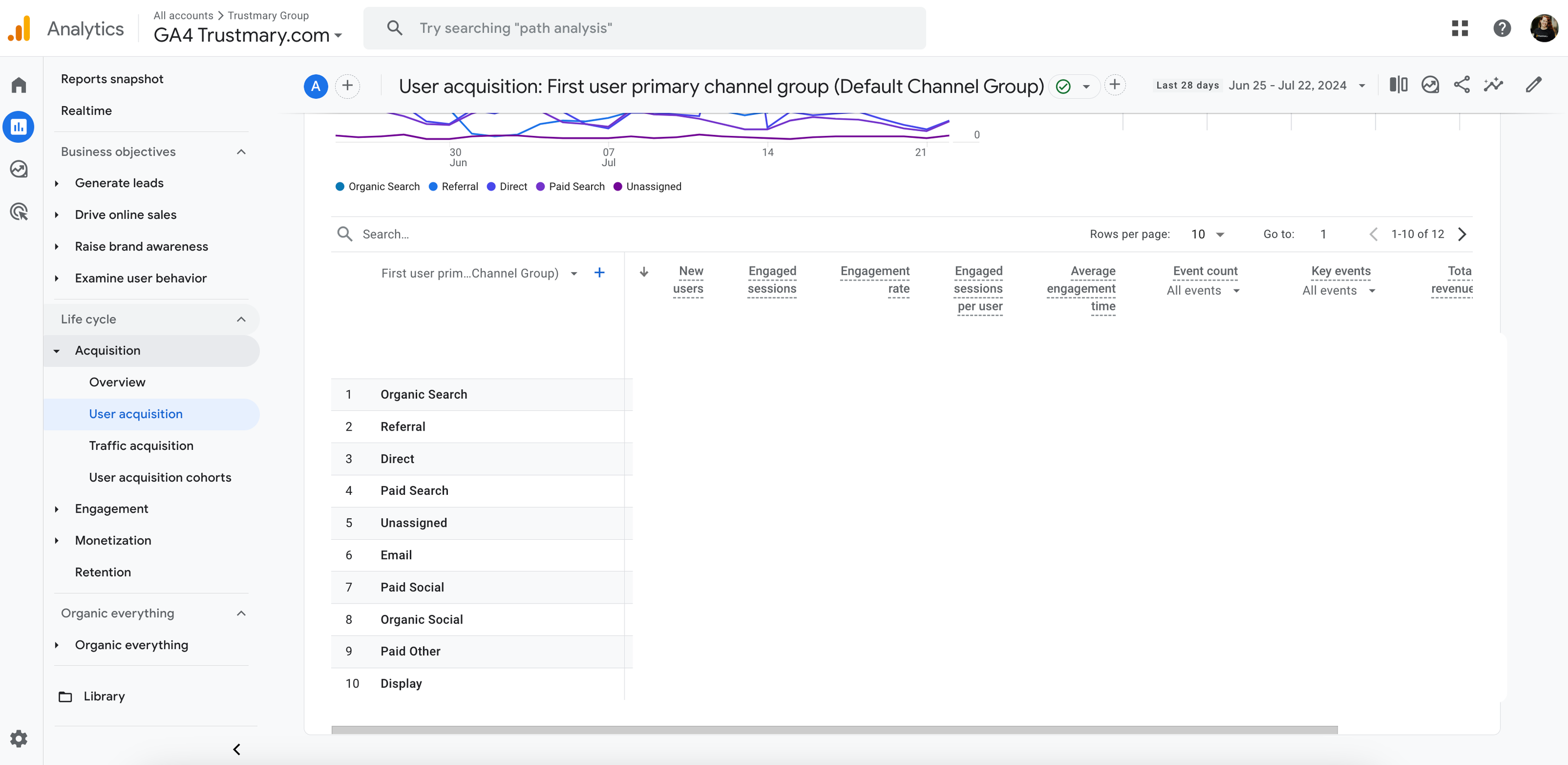
I’ll use them to go over the basic SEO metrics and throw in a few that I’ve found useful when explaining SEO results.
If GA4 feels tricky to manage, I highly recommend following Dana DiTomaso on LinkedIn. I’ve learned so much just by following her insightful posts.
Plus, to make GA4 more comprehensible for non-SEOs, she uses a method where she names custom reports as questions her customers are looking for the answers to, for example:
“Where is my traffic coming from?”
“How has my traffic changed over the last 30 days?
I’ve found this method really helpful, so alongside each metric I’ve also provided the question the metric answers:
How many visitors are coming to my website?
Traffic volume is one of the most reported metrics in SEO, even though it’s arguably a vanity metric.
This can be looked at on a daily, weekly, monthly, quarterly, or yearly basis.
How many people coming to my site are active?
This is about the users who perform activities on your site.
If you use GA4, this is just one of its user metrics. The more active users you have, the better. It shows you’re creating helpful content.
How many people are engaging with my site?
In GA4, an engaged session is defined as sessions that:
How long do people spend on individual pages on my website?
This is a nice metric to track for each URL, and it gives you insights into how your content is consumed.
For example, if you have a 3,000-word article, but people spend just 15 seconds on the page, you likely need to make some improvements.
How many of my website visitors are coming back to my site?
Returning users are a part of the total traffic volume metric, but it’s interesting to track how this metric changes over time.
It’s a great thing to get people to revisit your website. It means you’ve managed to stay top of mind, and the returning visit might just be the one that gets browsers to convert into users or even customers.
What do people do on my site?
I’m talking about scrolls, pageviews, form interactions, video engagement, and clicks.
Events in GA4 are tracked automatically, but you can also create custom events if you can’t find a suitable one in GA4 standard events.
Understanding what people do on your site can help you optimize your content and increase conversions.
The thing that SaaS companies care about above everything else is how you get signups and how valuable each signup is.
I’ve compiled a table of the most popular SaaS SEO metrics here, and I’ll describe them in more detail after the table.
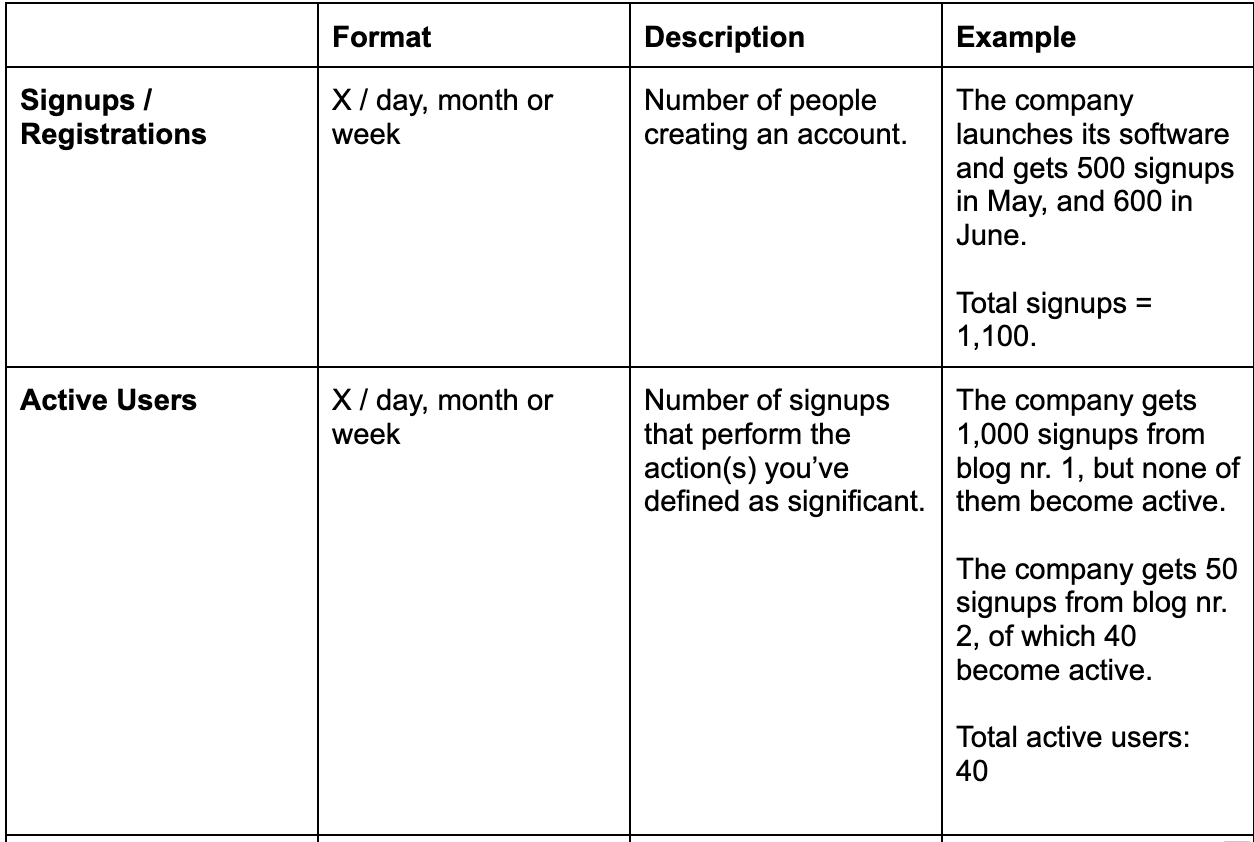

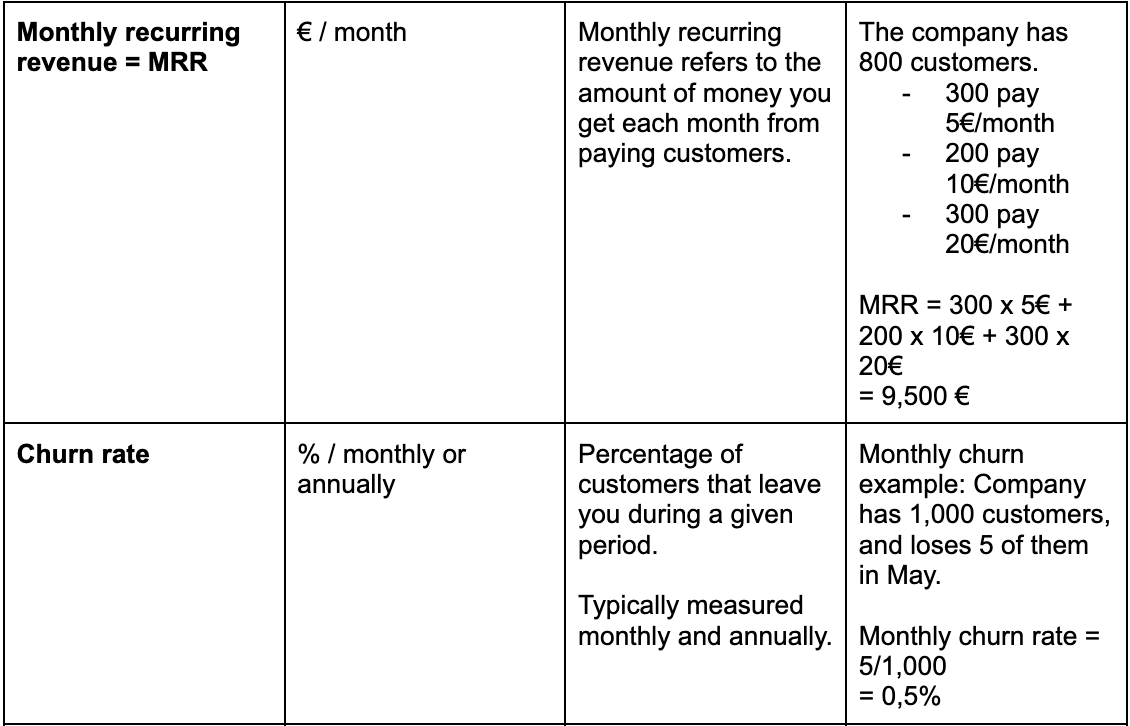

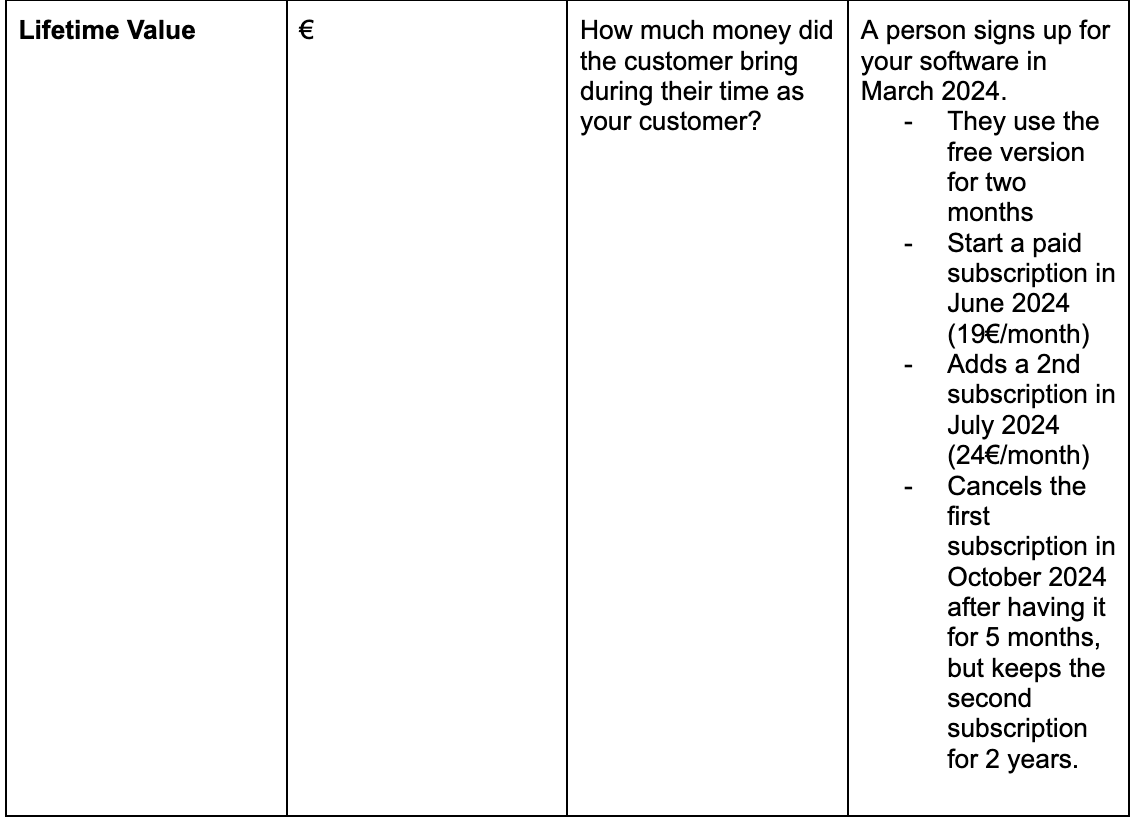
Here I’m referring to the number of website visitors that create a free account and start getting to know your software.
The key thing to keep in mind: Not all signups are good, and some should even be ignored.
Focus all your attention on this, as these are essentially qualified leads - they’re not paying for your software yet, but they are making use of the free version.
The definition of active user is different for all brands, but being an active user can be measured, for instance, in:
Note that each company defines active users differently, but essentially active users are those who have the potential to become paid users down the line.
Take the number of active users you get monthly and divide that by the number of total registrations during that time.
The activation rate on a specific URL helps you understand which pages bring in high-quality traffic. On some of our pages, the activation rate is 20-100%, and on some, it is at 0%, or very close to 0%.
The key is to identify what causes the activation rate to be low or high.
We have an article in Spanish that gets us a ton of signups every month. The blog post was published on the 13th of October in 2022, and to date it has delivered 5,264 signups.
But, only 9 became active users, and only one became a paid customer.

If we were measuring success in terms of registrations, this would be a pot of gold. Unfortunately, the activation rate is terrible.
These were the actions we took to try improve the quality of signups and activation rate:
All of these actions helped us decrease the number of monthly registrations but didn’t improve their quality much.
I think that this is one of the most interesting pieces of content that I track, as it holds so much potential. So, what’s the problem?
The search intent for the keyword is currently not well aligned with the software solution we offer. When you look up “review generator” you’ll see that SERPs are filled with AI review generators. But this is not what we offer:

Our software doesn’t generate fake testimonials, it helps streamline and/or automate the customer review collection process. With our solution, companies can create a review collection campaign in minutes, send it, and get authentic testimonials and reviews.
Fun fact: Search intent can vary by language. The English version of this article brought in a high value full-suite customer to us.
This is tricky for SEOs, as we typically can’t influence anything beyond the registrations.
I’ve struggled with accepting this metric as a part of measuring my work, but after a few years in SaaS, I’m starting to see the reason why this actually earns its place. Active to paid means how many of the active customers start paying either immediately, or further down the line.
These people affect the bottom line.
If you can attribute these customer acquisitions to organic traffic, you’re very likely to have leverage for your new projects.
MRR means how much money your business generates each month.
This is one of my key performance metrics. Again, this seemed harsh to me at first, but it has helped me:
1. Double down on the site content that I see working
2. Focus on the pages that have monetary potential, but aren’t yet ranking well 3. organically, so aren’t generating high numbers of signups
Think creatively about new ideas to bring faster results (more on this later)
The churn rate refers to the percentage of customers you lose in a given period. SaaS churn rates vary based on industry and market, but a good benchmark to aim for is 4% annual churn.
In plain English: Keeping 96% of your customers annually is considered good.
Again, this is also beyond an SEO’s sphere of influence, but it can be useful in proving that users coming in from organic traffic are more likely to stay as customers.
Customer acquisition cost (CAC) is often a paid ads metric or a combination metric for sales and marketing. However, it can be used by SEOs to measure how much it costs to get leads or customers from organic search.
All you need to calculate this are the monthly:
Add up the monthly costs and divide by the number of customers acquired.
This is also a nice metric to add when you’re explaining the value of SEO to stakeholders.
Customer lifetime value (CLTV) or lifetime value (LTV) are used interchangeably and refer to how much money a single account brings you during its time as your customer.
Some examples of LTV:
I’ve only done SEO in SaaS, and I’ve experienced several challenges in communicating the value of my work.
Here are some of the mistakes I’ve made in the past, and some things I’ve learned as a result:
It’s happened to me numerous times: I’ve fallen into the trap of showing SEO results or other interesting findings by sharing the raw data. The problem is no one really understands what the raw data means, and I fail to communicate what it is I’m trying to get across.
Since we created a customized Looker Studio report that blends GA4 data and SEMrush data, we’re now able to give an easy to understand visual overview of the metrics that matter (rather than ALL THE DATA).
Pro tip: Never show raw data, but come prepared with reports on the metrics that matter. Better yet, create a presentation with relevant data, your findings, and key learnings
We shifted our SEO focus in March 2023 to a more narrow bottom-of-funnel (BoFu) approach which had a big impact on our traffic. The reason is obvious: BoFu keywords in our niche are low-volume keywords, whereas the top of the funnel (ToFu) keywords are high volume.
After our traffic drop in October 2023, it was tough to explain to everyone internally that it was actually not a bad thing, as the traffic we’d lost was from ToFu articles that weren’t all that relevant to our business goals at that time.
1. Exported traffic per URL in September 2023
2. Exported traffic per URL in November 2023
3. Exported signups, active, paid in September 2023
4. Exported signups, active, paid in November 2023
5. Imported everything to Sheets
6. Calculated the drop/increase in traffic in one tab
7. Calculated percentual traffic change in one tab
8. Sorted the table by change in relation to all traffic
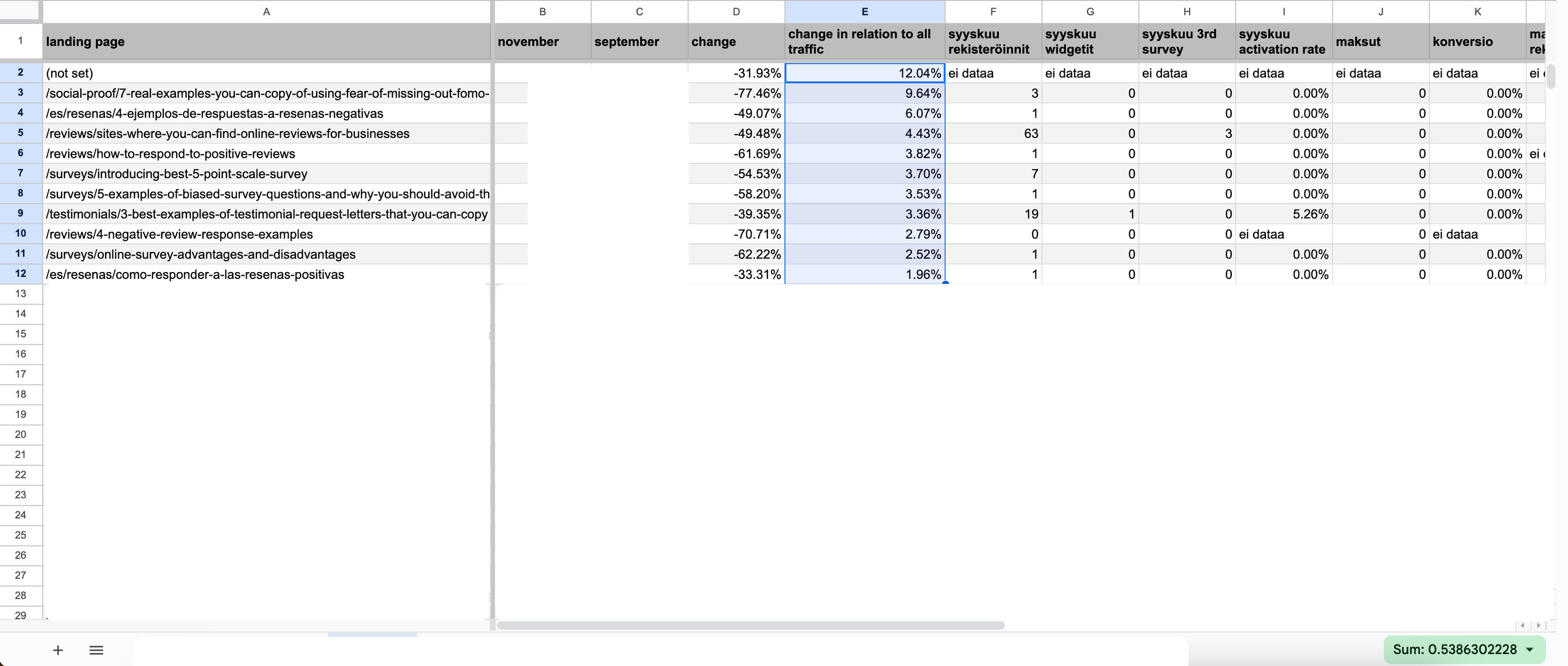
If you’re like me, you might also find it hard to get buy-in for fixing technical SEO issues.
Here are some things that have helped me get buy-in.
I’m lucky enough to have a bi-weekly website check meeting where marketing, design, and development go over any issues anyone has encountered with our website. This forum has enabled us as a business to have a more holistic approach, because everyone can suggest, influence, and suggest improvements.
Corinna Vorreiter said in her presentation at WTSFest Berlin 2024 that SEOs need to be persistent in getting technical fixes done, and I 100% stand behind that.
If you have a gut feeling that something is a good idea, get the data to back it up, create a business case, and stand your ground.
Long answer: I’ve had MRR as my KPI metric for a year now. When it was first introduced, I tried my best to try to get that changed to a more relevant metric, as I felt it was out of my control to influence. We had numerous discussions about it and at times I felt discouraged.
However, I’ve grown to like MRR, because it helps me focus on figuring out what really impacts our business’ revenue.
Now we’re getting to the really juicy part: How to prove your value in SaaS when you do SEO.
Make sure you’re tracking everything! When I started, I manually tracked where people who booked a meeting with us came from. It required me to look up the email address from Mixpanel which we use to track user activities, open their profile, and check what their “marketing_url” was.

I didn’t have the knowledge or resources to automate that process, and we only had a few coming in each week. But when I saw that the person booking a meeting was coming from organic, I made sure to shout it to everyone within the company on Slack and in person.
We’ve since set up proper tracking for meetings, but tracking manually helped me prove my point: My work generates real tangible results, and everyone should take note.
Do you know which brings more money down the line: people converting from paid ads, organic traffic, or social media?
The most important thing is to prove that SEO is a profitable segment. For this, you’ll need to combine Customer Acquisition Cost (CAC) with Lifetime Value (LTV).
CAC is a key metric when a company is looking for investors to speed up growth. SaaS CAC can be tough to calculate, but for SEO it can be done in the following way:
1. Add up all the costs
2. Pull the following data:
3. Calculate the CAC
4. Prove profitability
Example:
Expenses are 10,000€/month, and the company gets 100 new customers a month
→ 10,000/100 = 100
= The cost of one customer is 100€.
That makes the CAC in this case 100€.
For this company’s SEO efforts to be profitable, the average customer lifetime value for organic customers needs to be a minimum of 300€.
Now’s a good time to calculate your own CAC and LTV. If CAC is more than three times your LTV, you’ll have a great chance of getting more resources already just by showcasing your calculations and new ideas.
If it’s not quite there yet, make a detailed calculation of how you think you’ll make that happen if you get more resources
I’d recommend everyone working in SEO to look at ways to incorporate either some or all of these SaaS metrics into their reporting – after all, our success should be measured in terms of the value we generate.
As for my company, we’re currently in the process of exploring the impact of improved rankings for our most relevant top of the funnel (ToFu) keywords. But we’re still more focused on quality. It warmed my heart to hear even our Product Manager (former CMO) Arttu Haho say:
“But let’s not focus on traffic numbers alone, but more on the quality of the traffic”.
By using SaaS metrics, I feel I’ve finally been able to get the right kind of SEO message across to other teams internally as well.